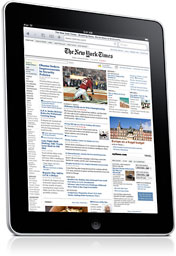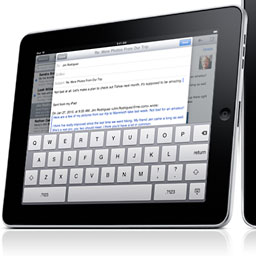Steve Jobs introduced Apple's newest innovation, the iPad, last week. Within a day, technology
pundits began sharply criticizing the device for a variety of
reasons.
While Apple hasn't made a flawless product, I believe the true
reason behind the intense negativity stems from one simple fact: They
don't understand the device and how it may very well revolutionize the
field of mobile computing.
The Screen
One of the features of the iPad that has been most attacked is
rather prominent, the screen. While I can see how the battery life
would be negatively affected by the IPS technology in the 9.7" display,
I think the jump to LED backlighting - something that has not been
common outside the Apple product line - will help the device conserve
power to still allow for healthy battery life.
 I also think that criticism of the screen's
resolution is unfounded. To keep the device small and affordable, Apple
made a sound choice in going with a 1024 x 768 resolution screen with a
4:3 aspect ratio. Even though this is not optimal for most videos, the
tablet's main purpose is to be usable as a tablet, not as a
portable video player. If a 16:10 or, even worse, a 16:9 ratio had been
used, a much larger panel would have been required to allow for enough
screen width when working in portrait mode, destroying the mobility
advantage.*
I also think that criticism of the screen's
resolution is unfounded. To keep the device small and affordable, Apple
made a sound choice in going with a 1024 x 768 resolution screen with a
4:3 aspect ratio. Even though this is not optimal for most videos, the
tablet's main purpose is to be usable as a tablet, not as a
portable video player. If a 16:10 or, even worse, a 16:9 ratio had been
used, a much larger panel would have been required to allow for enough
screen width when working in portrait mode, destroying the mobility
advantage.*
Unfortunately, much of the tech industry, fueled by the increase in
high definition (HD) content, has become addicted to widescreen
displays, which are not as wonderful as they are made out to be. In
fact, having used a 1080p display as the primary on my iMac, as well as
seeing the new 21.5" iMacs
with these 16:9 displays, I can tell you that widescreens with high
resolutions are often very bad. To me, the new iMac's display has too
much pixel density to be as usable as the older 20" models. In fact,
the 24" Acer display that I use seems to be the minimum size for this
resolution, since its about as tall as the iMac's built-in display.
Also, if the resolution on the iPad had been any higher, its likely
that the smaller images and text would have been hard to read,
especially by those who are not in possession of young eyes with 20/20
vision.
More than a Big iPod touch
Another widely heard gripe about the iPad, one that is especially
unfounded, is that it is nothing more than a big iPod touch. This is
mainly heard from people who wanted this to be Apple's version of the
Axiotron Modbook, a MacBook
converted into a tablet. Often, this is also the same crowd who thinks
that Apple should make a netbook.
...the iPad is a better answer for the average
netbook user.
 What they don't seem to understand is that the iPad is a better
answer for the average netbook user. The iPad allows one to browse the
Web, manage email, listen to music, watch videos, manage photos, read
books, write documents (like this column), and create presentations -
as well as much more through third party apps designed with the iPad in
mind. These are also the things that a netbook is designed to do.
What they don't seem to understand is that the iPad is a better
answer for the average netbook user. The iPad allows one to browse the
Web, manage email, listen to music, watch videos, manage photos, read
books, write documents (like this column), and create presentations -
as well as much more through third party apps designed with the iPad in
mind. These are also the things that a netbook is designed to do.
Unlike a netbook, the iPad has been optimized to do these tasks on a
small screen with a mobile processor. The netbooks I have used
generally have small screens and don't run very fast. On top of that,
they either run a hobbled Linux distribution or a basic version of
Windows, neither of which are particularly graceful. That's exactly why
Apple decided not to attempt to build a netbook running OS X: it
doesn't want a sub-par user experience that might reflect badly on the
Mac itself.
Not only that, but the iPad will perfectly fill the device gap that
I, and many others like me, have. I don't want to carry a laptop around
with me, but an iPod touch or iPhone is too small to do real work on
the go. The iPad does precisely what I need. If I had one right now, I
would be typing this column on it, rather than using my heavy laptop.
In fact, when I buy an iPad at the release in late March, it will
become a regular accompaniment to my other school supplies when I leave
the house every morning.
iBooks
The other thing that the pundits have been blasting is the iBooks
app. They claim that the iPad will never be able to display ebooks as
well as Amazon's Kindle.
While the LCD might not be the optimal display technology for
ebooks, the iPad can also do a lot more than read books. Once again,
the technologists have missed the point that the iPad is a tablet and
needs to be a useful tablet, not just a good ebook reader.
Also, the pundits are actually wrong on the utter superiority of
e-ink displays. They compare the e-ink experience to reading off an LCD
monitor that is not optimized for ebooks and a smartphone display that
is too small to read on for long periods. I personally use a ebook
reader that has a backlit LCD screen, and I have found it superior to
the e-ink readers I have tested, including the Kindle. I experience no
eyestrain over long periods, like I do on my iMac and iPod touch, and
it is backlit, so you can read it in the dark. It even works rather
well in direct sunlight, although not quite as well as e-ink.
Also, because iBooks is merely one application among thousands, the
iPad (with its color screen) has a lot more utility than the Kindle.
People I know who would never drop $259 on a 6" Kindle - let alone
nearly $500 on the 9.7" DX - will be in line on release day for the
iPad, and I include myself in this group. In fact, my math teacher, who
owns every Kindle model, including the DX, is going to buy an iPad and
is seriously considering replacing both of her current model Kindles
with it.
A New Category of Device
Hopefully, the computer pundit community will be able to step back
and take a more objective view of the iPad. Rather than comparing it to
everything else that has come down the pipe, the iPad is best viewed
the same way that Apple views it, as a unique third device that sits
between the smartphone-style device and the full-size laptop. In fact,
considering the price, it could almost be viewed as Apple's newest
low-end Mac. 

 I also think that criticism of the screen's
resolution is unfounded. To keep the device small and affordable, Apple
made a sound choice in going with a 1024 x 768 resolution screen with a
4:3 aspect ratio. Even though this is not optimal for most videos, the
tablet's main purpose is to be usable as a tablet, not as a
portable video player. If a 16:10 or, even worse, a 16:9 ratio had been
used, a much larger panel would have been required to allow for enough
screen width when working in portrait mode, destroying the mobility
advantage.*
I also think that criticism of the screen's
resolution is unfounded. To keep the device small and affordable, Apple
made a sound choice in going with a 1024 x 768 resolution screen with a
4:3 aspect ratio. Even though this is not optimal for most videos, the
tablet's main purpose is to be usable as a tablet, not as a
portable video player. If a 16:10 or, even worse, a 16:9 ratio had been
used, a much larger panel would have been required to allow for enough
screen width when working in portrait mode, destroying the mobility
advantage.* What they don't seem to understand is that the iPad is a better
answer for the average netbook user. The iPad allows one to browse the
Web, manage email, listen to music, watch videos, manage photos, read
books, write documents (like this column), and create presentations -
as well as much more through third party apps designed with the iPad in
mind. These are also the things that a netbook is designed to do.
What they don't seem to understand is that the iPad is a better
answer for the average netbook user. The iPad allows one to browse the
Web, manage email, listen to music, watch videos, manage photos, read
books, write documents (like this column), and create presentations -
as well as much more through third party apps designed with the iPad in
mind. These are also the things that a netbook is designed to do.
